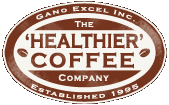Coffee Facts and Findings: Our "Cups" Runneth Over!
Coffee Facts and Findings: Our "Cups" Runneth Over! Coffee consumption in America and North America is such a daily ritual that it only strikes your attention when you don't see it taking place.
Lines at the local StarbucksTM or Coffee BeanTM on any given weekday morning are often longer than the voting lines in First Tuesdays in November. And if you don't think you and your friends are hooked on it, try getting through a morning without it, and just see just how that would set with everybody.
How many times have you tried to interact with a worker or friend only to be told something like, "Not now! I haven't had my coffee yet." To say that coffee is a habit bordering on a national obsession would probably not be understating the case. It is certainly a "tradition" in most nations, and is generally thought of as a good one. In truth, coffee has, in the last 200 years, become such a staple in the Western hemisphere that no social event, public gathering, convention or meal for large masses of people are ever held without taking the "coffee factor" into account. Such observations as the ones just made might be written off as "purely personal," until you start to take some statistics into account.
So, perhaps it's time we did. Coffee's Momentum Train Coffee is the number two beverage in the world - second only to water in total volume consumed. Coffee is nearly four times as popular as tea, the third most consumed beverage, and five times as popular as soda, which ranks fourth.
In 2006 alone, the specialty coffee market racked up an estimated $12.2 billion in sales, up from $8.3 billion in 2001. (according to the Specialty Coffee Association of America, a trade group based in Long Beach, CA) Of that total, about $8.5 billion comes from "coffee cafes, or beverage retailers with seating." The number of coffee retailers -- which includes chain and independent stores -- has risen from only 1,650 in 1991 to 23,900 by 2006.
The annual coffee consumption worldwide in 2003 was estimated to be approximately 400 billion cups. That's over 1.4 billion every single day - with more than 400 million of them consumed in the U.S. alone! The large Venti Latte (or extra large latte) at StarbucksTM now costs about $4 a cup. Some wealth and money mavens such as Finish Rich author David Bach offer a "cappuccino strategy" for start-up investors whereby people can save up to $1200 a year just by not getting their daily morning fix at StarbucksTM. The average American consumes about 10.5 pounds of coffee per year with the average Swede, Dane or Norwegian consuming well over twice that much (nearly 22 pounds per year).
If these facts seem astonishing, they only scratch the surface and do not take into account the momentum that coffee is enjoying even as of this writing. One might argue that it is the blanket of aromas, the taste, the hot nutty-sweet bite of flavor as it teases our tongue or the lush familiar warmth of our kitchen hearth and the bouquet of our mother's cooking. Others might answer that it is that "pick me up" jolt of energizing power that the beverage possesses like none other.
Regardless of the reason, something is driving the masses to consume this beverage in large quantities. Like anything else consumed in more-than-moderate doses, the question of health is bound to arise. So really, is coffee bad for your health? That's a question you've got to answer on your own, but we've got some information that might help you understand that loaded question a little more clearly.

No comments:
Post a Comment